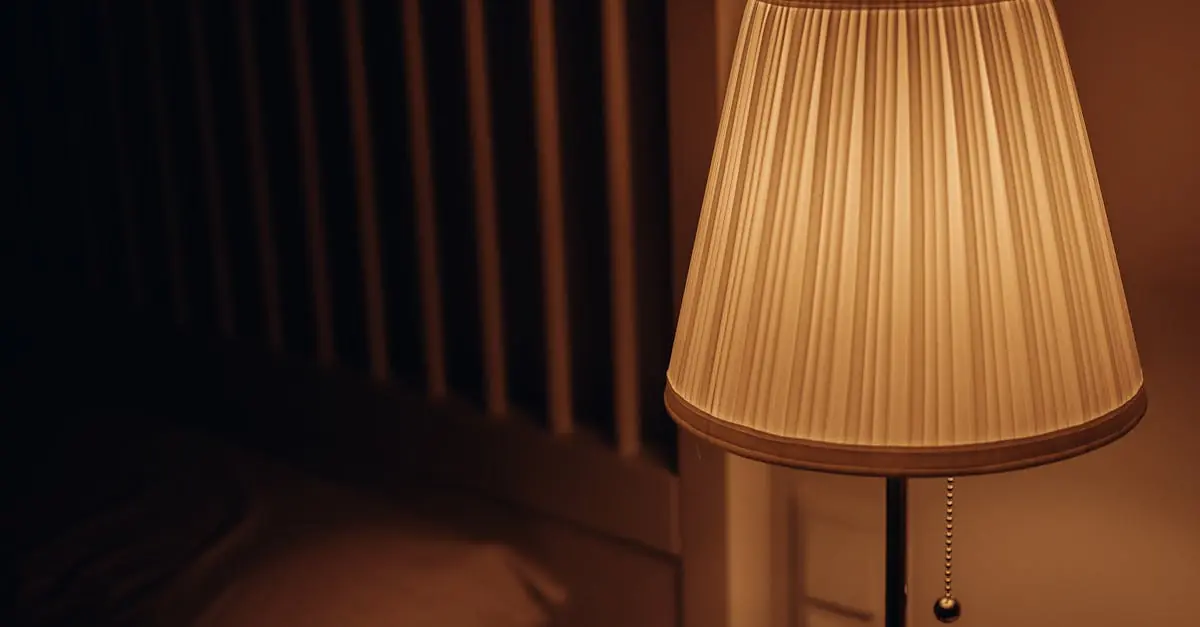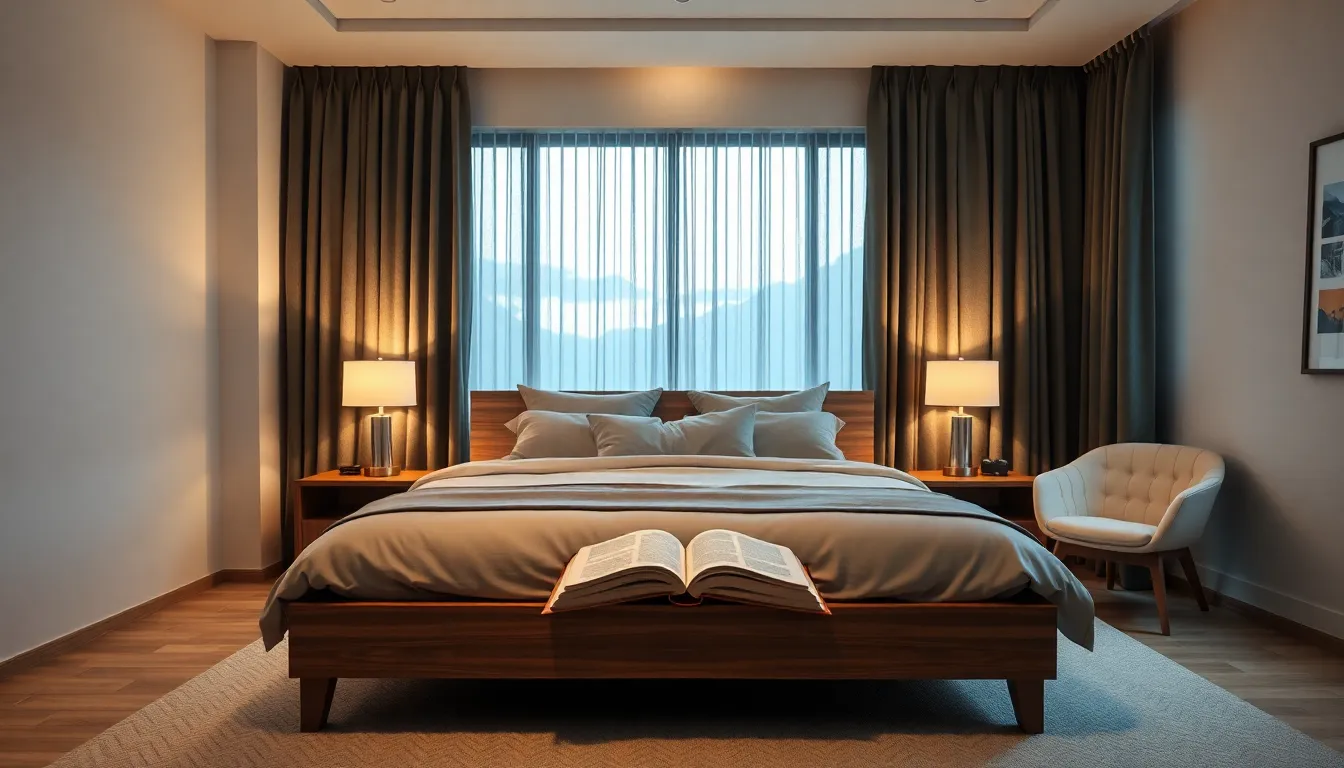Table of Contents
ToggleIn a world where sleep often feels like a luxury, ambient sleep lighting might just be the secret weapon everyone needs. Imagine drifting off to dreamland bathed in a gentle glow that whispers sweet nothings to your restless mind. It’s not magic—it’s science! The right lighting can transform a chaotic bedroom into a serene sanctuary, making it easier to catch those elusive Z’s.
Understanding Ambient Sleep Lighting
Ambient sleep lighting refers to the use of soft, low-intensity lights designed to promote relaxation and comfort during the evening hours. Individuals can create a serene atmosphere that aids in falling asleep more quickly.
What Is Ambient Sleep Lighting?
Ambient sleep lighting consists of gentle light sources that fill a space with a soothing glow. These sources include smart bulbs, LED strips, and bedside lamps. Unlike harsh lighting, this type provides a calming effect, reducing stimulation and preparing the mind for sleep. Popular options often shift in color temperature, transitioning from bright whites to warm hues. As a result, they enhance the ambiance of a bedroom, leading to improved sleep quality.
How It Works
Ambient sleep lighting functions by mimicking natural light patterns. This approach influences the body’s circadian rhythm, signaling when it is time to wind down. Soft hues, such as warm white or soft amber, promote melatonin production, a hormone crucial for sleep regulation. Additionally, dimming lights gradually can ease the transition to sleep, allowing the body to relax. Many systems allow for customization, enabling users to choose timing and brightness levels that suit their preferences. Such features optimize sleep environments and make bedtime routines more effective.
Benefits of Ambient Sleep Lighting
Ambient sleep lighting offers numerous advantages that contribute to better sleep quality and an overall calming environment.
Enhancing Sleep Quality
Ambient sleep lighting plays a crucial role in improving sleep quality. By mimicking the natural light patterns of sunset, these lights help regulate the body’s circadian rhythm. As the evening approaches, softer illumination signals the brain that it’s time to wind down. Studies show that reduced exposure to bright light before bed promotes melatonin production, aiding in the transition to sleep. Furthermore, customizable features allow users to adjust brightness, creating the optimal setting for relaxation. This combination of factors leads to deeper, more restorative sleep.
Creating a Relaxing Environment
Ambient sleep lighting significantly contributes to a relaxing environment. Low-intensity lights create a soothing atmosphere that alleviates stress and anxiety. By minimizing harsh lighting, they reduce distractions and promote tranquility in the bedroom. Utilizing smart bulbs and LED strips enhances personal control over the lighting experience. Adjustments can be made to match individual preferences, fostering a cozy sanctuary for rest. Many users find that this calming setup encourages enjoyable bedtime routines, making it easier to unwind and prepare for sleep.
Types of Ambient Sleep Lighting
Ambient sleep lighting includes various options that cater to personal preferences and enhance sleep quality. The right type of lighting can greatly influence relaxation and create a calming bedroom atmosphere.
Smart Lighting Solutions
Smart lighting solutions offer advanced features for customizing sleep environments. Users can adjust brightness, color, and timing through mobile apps or voice commands. Some smart bulbs gradually dim over a set period, mimicking natural sunset light. Integration with sleep tracking apps allows users to sync their lights with sleep data, optimizing their sleep cycle. These solutions not only enhance ambiance but also provide convenience, making bedtime routines smoother and more efficient.
Color Temperature Variations
Color temperature variations play a critical role in promoting restful sleep. Warmer color temperatures, typically in the range of 2700K to 3000K, reduce blue light exposure. Soft yellows and warm whites create a relaxing environment that signals the brain to wind down. Cooler temperatures, above 4000K, may lead to alertness and interfere with sleep. By utilizing warm-toned ambient lights in the evening, individuals can foster a more conducive sleeping space, ultimately improving sleep quality and duration.
Choosing the Right Ambient Sleep Lighting
Selecting appropriate ambient sleep lighting greatly influences sleep quality. Identifying specific needs and preferences helps in making an informed choice.
Factors to Consider
Brightness is a crucial factor. Low-intensity lighting creates a restful environment. Color temperature also matters; warmer tones (2700K to 3000K) enhance relaxation, while cooler tones (above 4000K) disrupt sleep. Dimming capabilities play a significant role too; lights that gradually dim mimic nature’s sunset, signaling the body to unwind. Lastly, compatibility with smart home systems enhances convenience, allowing users to control settings easily through apps or voice commands.
Popular Products on the Market
Numerous products cater to varying needs in ambient sleep lighting. Philips Hue smart bulbs offer adjustable brightness and color temperature, creating ideal settings for relaxation. The Wyze Night Light features motion sensors and soft glow, providing hassle-free navigation at night. Additionally, the Hatch Restore combines a smart alarm clock with customizable light and sound features, perfect for establishing soothing bedtime routines. Each option contributes to crafting a personalized sleep sanctuary for improved rest.
Ambient sleep lighting offers an innovative approach to enhancing sleep quality. By creating a soothing environment that mimics natural light patterns, it helps individuals unwind and prepare for restful nights. The customizable features of these lighting solutions allow users to tailor their sleep settings to personal preferences, ensuring a calming atmosphere.
Choosing the right ambient lighting not only promotes relaxation but also supports the body’s natural rhythms. Whether through smart bulbs or bedside lamps, incorporating ambient sleep lighting into a nighttime routine can significantly improve overall sleep experiences. Embracing this simple yet effective solution could lead to deeper, more restorative sleep and a more rejuvenated start to each day.







